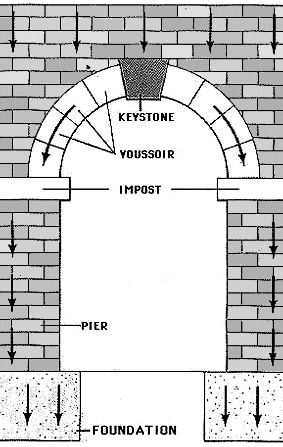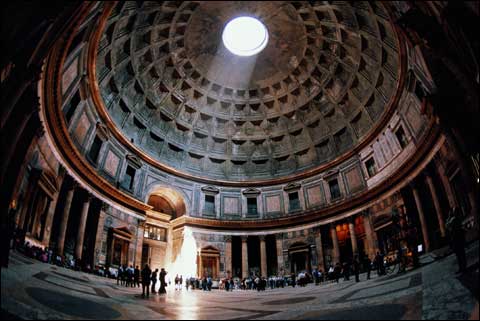Sometimes I wonder why I stick with you, I mean you can be a lot of work. Do you even know how hard it is to drag you through time and space against your will like this? Forcing you to learn about artistic historical feats all over the ancient world for my crazy professor you've never met and think doesn't exist? I mean really, this is exhausting!
Yup, I'm just a saint, a martyr even. Well maybe not that last one, but still, you're so lucky I do so much for you. Now come on, the professor needs us to go take a detailed record of the unique architecture of Rome. Why are you resisting like that? Am I going to have to drag you into the time machine again? Wow, you're hard to drag, you should have laid off on the gyros!
Welcome to 8th century B.C. Rome! As you will soon see, the Romans excelled in art and architecture, they stole ideas and methods from many cultures and perfected them. They assimilated all other cultures, quite a feat if you ask me! Did you know the Romans were also the inventors of concrete? Yup, but after they fell the recipe for concrete was lost until the Renaissance era.
Romans used arches and vaults in architecture. An arch is a cured architectural element used to span an opening, and it had a keystone on the top to support the entire arch. Arches may look simple, but the architecture is a bit complicated:
(Image found
here.)
There are many different kinds of arches besides that simple one.
A vault is an arched roof of covering made of brick, stone, or concrete. There are many different kinds of vaults, here are a few that are often seen in Roman architecture:
Let's go see the Colosseum now, it has an archade! Nope, not those kinds of games, but many arches supported by pillars

The Colosseum is 16-stories high, 144 feet tall. It can fit 50,000 people. Three emperors were involved in its construction: Vespasian, Titus, and Domitian. The Colosseum is made of concrete, the outside was decorated with plaster and marble. The Colosseum is built with the Standard Roman Sequence of architecture, which went from Doric at the bottom, then Ionic, then Corinthian at the top. This sequence was used often in Roman architecture, hence the word "standard." Statues filled the niches in the walls, and the statues were very ornate, painted, and had glass eyes. They were mostly Greek copies. When it rains, there is a giant tarp of canvas called the velarium which was so big and heavy it took 1,000 men to lift it over the top. The Colosseum was the ultimate entertainment center, and Romans were all about entertainment. A few of the "shows" commonly held here were gladiator battles and mock naval battles since the Colosseum could actually be filled with water!
People had tickets to get in, and they sat at different labeled sections, most likely separated by class. The ruins of the Colosseum still stand in even my time! However, the whole thing would probably still be standing if the Romans hadn't pilfered so much of it. They took most of the materials to use for other building projects- they called it resourceful, we call it ruining history.
Next stop on our Roman tour: the Pantheon.
The Pantheon was made to worship all gods. The general belief at the time was to worship any god you want, any of them will bring you closer to the real god or gods. The wall of the Pantheon are 20 feet thick to support the giant dome. The floors were 144 feet in diameter and the dome is 144 feet from the floor. The dome walls were coffered, which are inlaid boxes. The dome is thicker at the base and gets thinner towards the oculus. The oculus is the 30-foot-wide hole at the top of the dome that allows
light in, symbolically it was meant to be god's eye watching over
everyone.
Because there is a hole in the roof, rain comes into the Pantheon. It doesn't flood, however, because there is a drainage system in the ground. The doors and the dome were originally covered in gold until all the gold was pilfered, like much of the Colosseum was. In the front of the Pantheon is the portico, the porch which is supported by Corinthian-style columns.
I'm tired of these busy streets and the dusty Colosseum, let's go take a bath!
Yeah, you heard me, we're gonna go check out the Roman baths!
...Don't look at me like that, they're separated by gender! Well... most of them are.
Anyways, let's just go check it out.
The baths are a big social gathering for Romans, most people will go at least once a week, the rich people sometimes even go twice a day! Romans are so hygienic! The baths are separated by class, see those sad little ugly puddles over there? Those are the servant baths. And that giant one that looks like a Tahitian resort's pool is the rich peoples' bath. They have three temperatures of water: the coldest, the fridgidarium, the tepidarium which is room tempurature, and the caldarium which is hot. Usually they would go to the tepidarium, then the caldarium, then back to the tepidarium, then into the fridgidarium. The Romans believed that going in these different extreme temperatures was healthy.

These baths had changing rooms which had niches in the walls to hold clothing. Special sandals with thick soles were needed for the baths because the floor was heated (except in the fridgidarium) to keep the baths warm. Walls and floors were heated by a furnace system called a hypocaust, where the baths were above a raised floor, underneath which was an air channel for the warm air to circulate.
(Image and above information found
here.)
Okay, now that we're nice and clean it's time to go do some more sight-seeing!
(Image found
here.)
This is the Arch of Constantine. It's a triumphal arch that commemorates
his assumption to power. It's covered in sculpture carvings about how
great he is. He must have been quite narcissistic to want to be
remembered for all time in such a giant arch.

(Image found
here.)
This is our next stop, the Forum Romano. It was a meeting place for Romans to discuss. It was the town square, and the political and religious center. It was also a very large market.

(Image found
here.)
I'm sure that you're starting to notice that Roman is very advanced for it's time. It's clean, the people are hygienic, and the city is planned out instead. Romans made paved roads, and were the only ones to pave roads at this time, so all roads truly did lead to Rome! They also had a sewer system, a fresh water system, and plotted out "zones," like in my time, where certain land is set aside for certain purpose, like industrial land and residential land. The wealthy homes were often two-stories, had different rooms for different purposes (to worship, to entertain, to eat, ect.) and most had a garden or atrium of some sort. Romans even learned how to make pressurized fountains without electricity!
So many architectural advancements we have in my time were based off ancient Rome.

(Artistic blueprint of a Roman house found
here.)
As I said, the Romans have a fresh water system, or aqueducts. These aqueducts were composed of arches and vaults, and went from the mountains where the fresh water was all the way to the city. The water in the aqueducts flowed into the city by the force of gravity; the aqueducts had a grade of only half an inch per mile to achieve this! They were made out of concrete, which is heavy, durable, and cheap. Romans would repair the aqueducts during the summer when it was warm because the concrete had expanded, exposing all the cracks. Rome had 77 aqueducts that supplied Rome with 350 gallons of water per day! This was the most advanced water system of the ancient world.

(Image found
here.)
We'd better find a hotel for the night, it's getting late. Tomorrow, in Part 2 we'll go see some actual art!










 (Image from here.)
(Image from here.)














